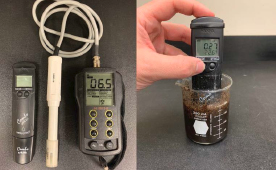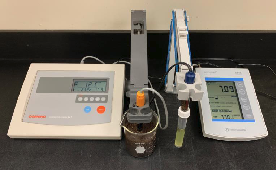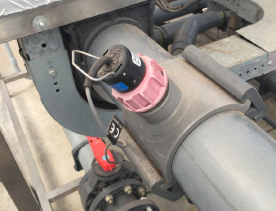

Measuring pH and electrical conductivity (EC) can be used to check the quality of irrigation water, calibrate fertilizer and acid injectors, and measure nutrients and availability for plant uptake in applied fertilizer solutions and the root zone. Several types of pH/EC meters are available, and vary in size, cost, and how they are used in horticultural practice.
It is important for growers to choose a meter that best meets the measurement needs of their operation. This e-GRO Alert discusses the basics of using pH and EC meters, common types for greenhouses and nurseries, and relative costs.

Basics of using pH and EC meters
What is pH? pH refers to the acidity-basicity of a solution, which influences the solubility and availability of nutrients for plant uptake. This is particularly the case for micronutrients like iron, manganese, and boron. A pH < 7 is acidic, pH > 7 is basic, and a pH equal to 7 is neutral. For most plant species, nutrients are adequately available for uptake at a slightly acidic root zone pH between 5.6 and 6.4.
What is EC? Electrical conductivity (EC) is a measure of total soluble and dissolved salts in solution. EC is measured in units of electrical charge. Dissolved nutrients and non-essential ions such as sodium and chloride all contribute to the EC. EC does not indicate specific concentrations of nutrients or elements — this would require sending samples to a commercial testing laboratory.

Choosing the right pH/EC meter
Calibrating and storing pH and EC meters. Regular calibration and maintenance of pH/EC meters ensures measurement accuracy and a long meter shelf-life. pH sensors can become damaged if they dry out, and should be kept protected in a proper storage solution when not in use. EC sensors can usually be stored wet or dry without damage. It is important to keep standard calibration and storage solutions on stock for your pH/EC meter, and refer to the instruction manual for guidelines on using, calibrating, and storing meters.
Testing pH and EC. Monitoring irrigation water EC is important because soluble salts in the water supply can fluctuate and influence fertilization and irrigation. Checking pH and EC of applied fertilizer and hydroponic nutrient solutions helps determine whether fertilizer and mineral acid injectors are working and if sufficient nutrients are being supplied. Measuring root substrate pH and EC can indicate the quantity and availability of nutrients for plant uptake.
To learn how to calibrate fertilizer injectors using EC meters, check out the University of New Hampshire Extension article by Dr. Brian Krug titled ‘Fertilizer Injector Calibration’ (here).

Common types of pH and EC meters
Hand-held and portable meters. Sometimes referred to as “pen” meters, hand-held and portable meters are battery-powered, low cost and practical for both small and large grower operations (Figs. 1 and 2). Many are combination meters and measure pH and EC. An advantage of hand-held/portable meters is that they can be carried easily by workers to conduct “spot-checks” of pH/EC in the greenhouse. Some pH/EC meters have special “needle” probes designed for sticking directly into substrates, but most are designed to measure in liquid or extracted substrate solution. The cost of many hand-held and portable meters ranges from approximately $100 to $300.
Bench-top pH/EC meters. These meters are placed on benches or tables as shown in Fig. 3, and typically consist of separate pH and EC sensors plugged into an electronic console. Some consoles can log measurements for record-keeping, and may also have options for measuring individual nutrients, dissolved oxygen, and other parameters. Bench-top meters are common in research laboratories and large growing operations that process numerous samples. Bench-top meters are usually more expensive compared to hand-held meters and range from approximately $500 to over $3,000.
In-line pH/EC sensors. “In-line” sensors are installed in irrigation pipes or reservoir tanks to monitor pH and EC of fertilizer solutions entering and leaving the crop (Fig. 4). Sensors are often linked with environmental control computers and injection systems for automatic injection of mineral acids/bases and fertilizer to maintain target pH and nutrient levels (Fig. 5). In-line sensors for pH and EC are relatively inexpensive (<$1000), but there are extra costs associated with installation, plumbing, and environmental control systems. In-line pH/EC meters are most common with larger growers as well as hydroponic operations.

Conclusions
pH and EC meters can be used to check the quality of irrigation water, calibrate fertilizer and acid injectors, and measure nutrient availability for plant uptake. Expect to invest at least $100 for a quality pH/EC meter and refer to the instruction manual for guidelines on proper use and handling. Hand-held and portable meters are lowcost and often practical for both smaller and larger growers. Bench-top and in-line pH/EC meters are more expensive, but often come with extra measurement capabilities and are useful in certain production and research scenarios.

Explore the August 2019 Issue
Check out more from this issue and find your next story to read.
Latest from Produce Grower
- Chilli thrips (Scirtothrips dorsalis)
- GS1 US Celebrates 50-Year Barcode 'Scanniversary' and Heralds Next-Generation Barcode to Support Modern Commerce
- University of Florida offers Greenhouse Training Online program on irrigation water
- Flower trends in full bloom
- Nominate an outstanding leader
- New Florida Extension Agent Will Teach Stakeholders About Food Safety
- Paint it black
- Regular checkups





